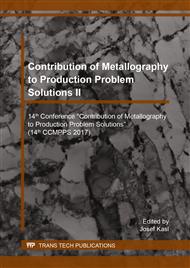p.15
p.21
p.27
p.34
p.39
p.45
p.52
p.57
p.63
Failure Mechanism of Yttria Stabilized Zirconia Atmospheric Plasma Sprayed Thermal Barrier Coatings Subjected to Calcia-Magnesia-Alumino-Silicate Environmental Attack
Abstract:
The contribution focuses on the description of failure mechanism of atmospheric plasma sprayed multilayer thermal barrier coatings subjected to calcia-magnesia-alumino-silicate (CMAS) environmental attack. To identify exothermic and endothermic reactions which occurred during heating/cooling by means of calorimetry was also utilized initial yttria stabilized zirconia (YSZ) powder subsequently used for thermal spraying of multilayer thermal barrier coating system (TBCs), CMAS powder later on utilized for thin layer deposition and its mixture. Atmospheric plasma spray technique was used to produce the TBCs on a grit blasted nickel-based superalloy substrates, where CoNiCrAlY powder was used for deposition of a bond coat and YSZ powder was sprayed as a top coat. In accordance to the aerospace standard the thin layer of CMAS was deposited on as sprayed TBCs samples surface from its colloidal solution by paint brush method. Burner-rig test, utilizing direct propane-oxygen flame, was used for thermal cyclic exposition of the multilayer coated samples at the temperature of 1150 °C. Samples after thermal cyclic exposure test were investigated by means of materialographic analysis approaches. The significant reduction in life-time of CMAS coated YSZ top coat was observed due to lower melting point phase formation and molten silicate crystallization within the pores providing the spallation identified as a major mechanism of TBCs failure.
Info:
Periodical:
Pages:
39-44
Citation:
Online since:
November 2017
Price:
Сopyright:
© 2017 Trans Tech Publications Ltd. All Rights Reserved
Share:
Citation:



